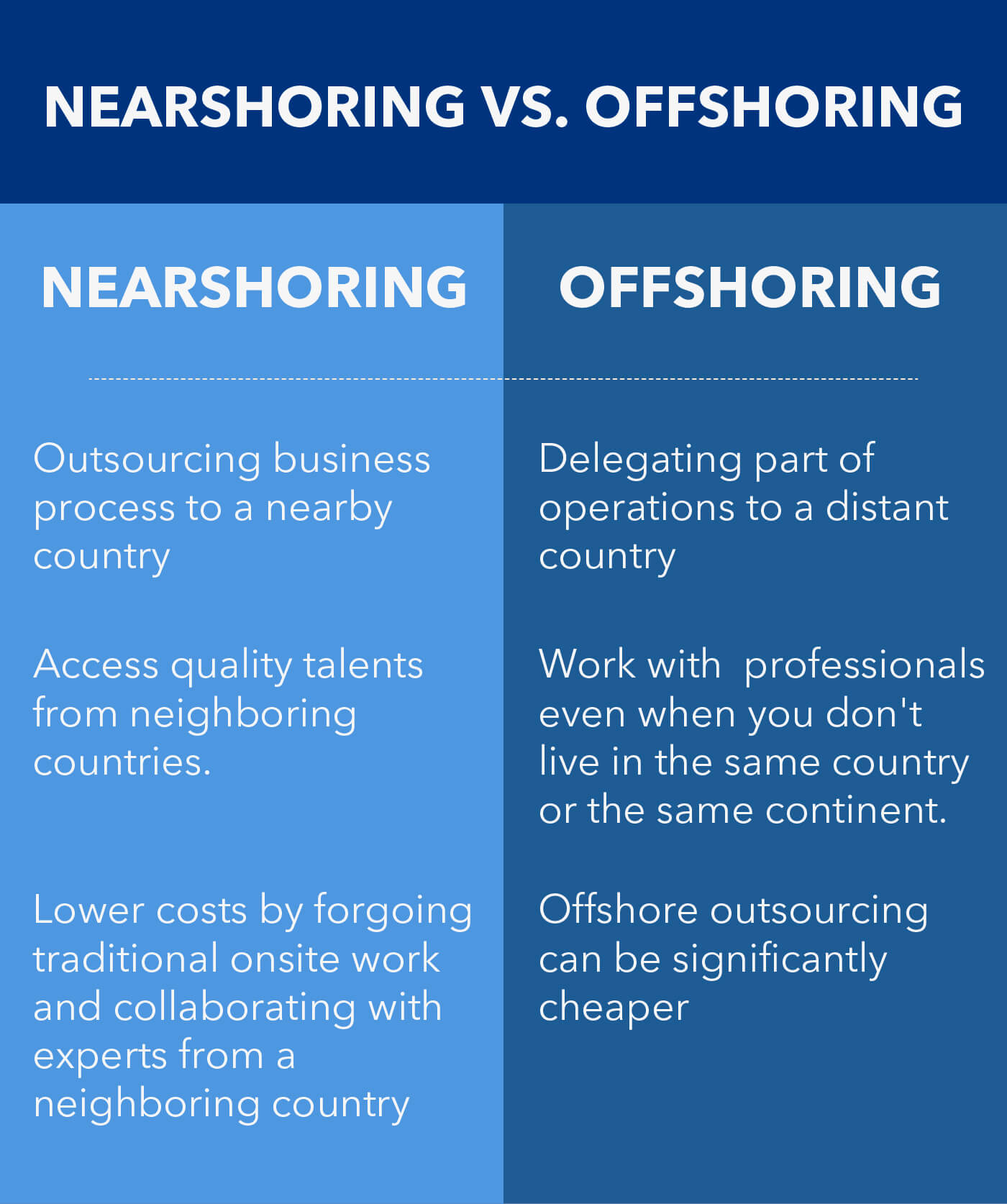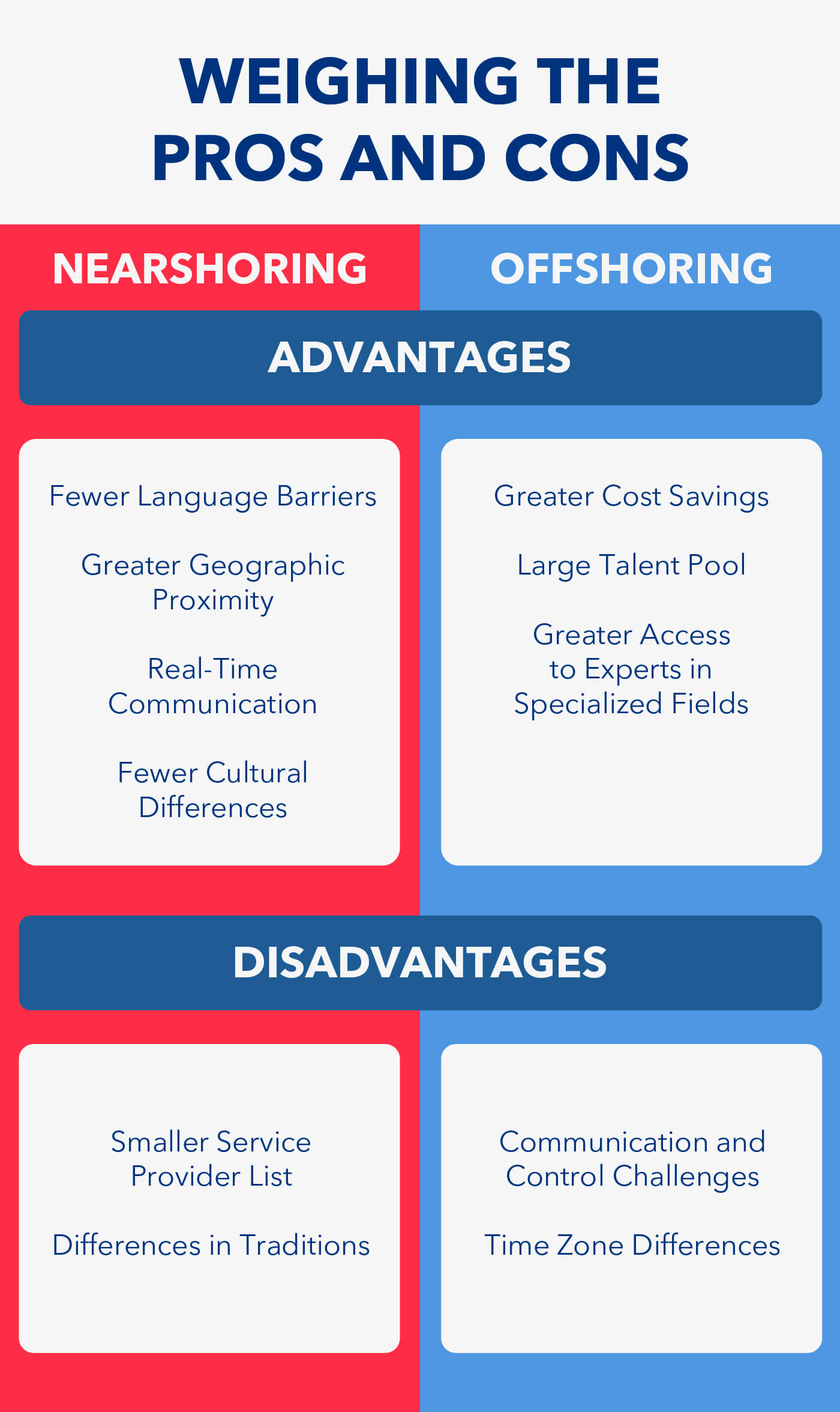
Picture this: You’ve been steadily growing your company, attracting new clients, dealing with rising market demand, and improving your bottom line.
As business booms, you quickly realize that your in-house team needs help to keep up with the additional workload and responsibilities.
How can you expand your workforce and capabilities quickly and without disrupting your business operations? In this case, working with an outsourced team may be what your company needs to thrive.
There are two different outsourcing models that can help scale your operations without breaking the bank: nearshoring and offshoring. This article will delve deeper into the differences between these solutions, weigh each one’s pros and cons, and help you determine which is ideally suited for your business.
Nearshoring vs. Offshoring: What Are the Key Differences?

Before diving into the advantages and disadvantages of the two outsourcing options, it’s crucial first to understand what makes each solution unique. Here are the main differences you should know:
Location
Offshoring, also known as offshore outsourcing, refers to the business practice of delegating part of their operations to experienced providers in distant countries. For example, a US business may outsource to a BPO in the Philippines, China, India, other Asian nations, or even Eastern Europe.
Meanwhile, nearshoring refers to when companies outsource their business processes to a third-party company in a nearby country. For instance, an American enterprise may hand off its support tasks to an outsourcing company based in Colombia, Mexico, Brazil, or other Latin American countries.
Talent Availability
The American labor market is facing its most formidable challenge yet: the ongoing talent shortages. As the COVID-19 pandemic and “The Great Resignation” wind down, many employers are still struggling to retain their local team.
In fact, there seems to be a disconnect between what employees want and what companies are willing to offer. According to Gartner, US workers expect a 5.5% pay hike in 2023, but businesses have only budgeted for 3.5% to 4.5%.
To address the narrowing US talent pool, many businesses have turned to outsourcing. With nearshore teams, your search won’t be limited to only onshore workers; you can access quality talents from Canada, Colombia, Argentina, Chile, or other neighboring countries.
Of course, if geographical proximity isn’t an issue, hiring an offshore team can widen your talent pool even further. You can work with skilled professionals even when you don’t live in the same country or the same continent.
Cost-Effectiveness
In addition to navigating labor shortages, US employers must keep up with inflation and the rising cost of running a business. Throughout the nation, varying from state to state, rent prices are increasing, creeping up to a median of $2,007 in November of 2022.
As the housing market heats up, US office rentals are also adversely affected. For instance, office space vacancies in Manhattan are increasing, yet the market still commands the highest asking price in the country, averaging $75 per square foot.
Instead of contending with the rising price of office buildings, some businesses are transitioning to a remote team setup, which can be more cost-effective. Through nearshoring, a company located within the United States can lower costs by forgoing traditional onsite work and collaborating with experts from a neighboring country.
If you’re open to an even greater cost reduction measure, consider working with a BPO provider from an offshore country. Compared to onshore or nearshore solutions, offshore outsourcing can be significantly cheaper, saving financial resources that you can reinvest in other areas of your business.
Nearshoring vs. Offshoring: Weighing the Pros and Cons

Now that you understand the differences between the outsourcing models, it’s time to take a closer look at the advantages of nearshoring vs. offshore outsourcing. Here are the pros and cons of each solution:
Advantages of Nearshoring
Fewer Language Barriers
Communication is crucial for building strong working relationships, and speaking the same language is the first step to achieving this. One key advantage of working with a provider from a nearby country is that there are bound to be fewer language barriers compared to offshore teams.
For example, Colombia has a massive bilingual population, with students learning to speak English and Spanish starting in elementary school. When you work with a BPO company in Colombia, you won’t have to worry about communicating effectively with your employees because many workers are well-versed in English.
Greater Geographic Proximity
For some industries, location is critical for ensuring the seamless running of the business. The manufacturing sector, for instance, benefits significantly from outsourcing its business operations to third-party companies near the US border.
The close geographical location enables businesses to lower overseas shipping costs, minimize supply chain issues, and simplify logistics, customs processing, and transportation strategies.
Real-Time Communication
In many sectors, timely decision-making and planning are essential to staying competitive, which involves communicating with all team members efficiently and effectively. When you need to work closely with your BPO provider, nearshoring is the more practical option over offshoring.
For example, Colombia shares similar time zones with parts of the US, allowing for easier remote collaboration since you won’t have to change your regular working hours to set a meeting or call. When necessary, you could even hop aboard a plane from Miami to Medellin, a key city in Colombia, and arrive within three and a half hours to visit your BPO location.
Fewer Cultural Differences
Another advantage of nearshoring is that the nations closer to your home country are likely to have fewer cultural barriers.
Let’s take Colombia and the US as an example. These countries have a few cultural differences in business, especially regarding flexibility and direct communication at work. However, Colombian and American cultures also share strong similarities, such as valuing hard work and having the need to foster good relationships in business.
Because of these cultural similarities, the nations have nurtured a great diplomatic relationship over the years, with Colombia even being America’s third-largest trade partner in Latin America. The two countries have maintained solid and mutually beneficial international trade agreements for over a decade.
Disadvantages of Nearshoring

Smaller Service Provider List
Although nearshoring is an excellent strategic option for many companies, not many BPO providers offer this business model. Once you meet vendors that provide nearshore outsourcing, you may still need help finding ones that meet your project’s specific needs and requirements.
Differences in Traditions
As mentioned previously, businesses face fewer cultural barriers when working with nearshoring providers, but that doesn’t mean that the differences are gone entirely. Some Latin American countries have cultural traditions or holidays (such as Dia de Los Muertos or Mistura) that are not observed by US businesses, which can potentially create scheduling conflicts.
Advantages of Offshoring
Greater Cost Savings
One of the main advantages of hiring internationally from a distant country is the significantly lower cost. Compared to having in-house teams or working with a nearshore provider, offshoring is the more cost-effective option.
For example, the average salary of a customer service representative in the United States falls between $31,901 and $40,100. Meanwhile, if you hire a call center agent from the Philippines, their average salary is between P16,400 to P26,100 or $296.81 to $472.37 (as of December 2022).
Offshoring can save you thousands of dollars in labor costs and operational costs since your BPO provider will also give you access to their existing infrastructure and technologies.
Large Talent Pool
In the age of “The Great Resignation,” many US companies struggle to find willing workers to fill their crucial job openings. Another advantage offered by offshoring is that it widens your talent pool beyond your borders, neighboring countries, and even beyond continents.
Greater Access to Experts in Specialized Fields
Some industries are more specialized and require niche knowledge that your team may not possess. One example is in the realm of software development and technical support.
Today’s tech and IT companies are ramping up their operations and building their development team, but many need help finding qualified talents. By outsourcing development to software professionals in the Philippines, China, or India, they can access niche expertise while minimizing additional costs.
Disadvantages of Offshoring

Communication and Control Challenges
Although offshoring offers many advantages, it can also present challenges, especially when communicating with your offshore team. Unlike nearby nations, a BPO provider based in a distant location will have greater cultural differences and language barriers, making collaboration and control more difficult.
Time Zone Differences
Offshore BPO companies operate in different time zones, making real-time meetings challenging to schedule. The distance between your home country and your chosen offshore location can also make in-person visits more time-consuming, costly, and inconvenient.
When to Choose Nearshoring
If your business needs a shorter supply chain between your factory or manufacturing plant and the end user, nearshoring can be your ideal solution. With a nearshoring provider, you can delegate crucial functions and tasks, such as logistics or supply chain management, to a BPO partner that you can communicate with in real-time and can easily visit when needed.
In addition, if you work in a highly regulated industry that requires you to keep your production process closer to home for tax-related or regulatory purposes, nearshoring can be valuable for keeping down costs while working within legal constraints.
When to Choose Offshoring
For business processes that don’t require synchronous communication, taking advantage of offshoring solutions can be the more practical option. For example, hiring an offshore customer service team can benefit your brand, giving your business 24/7 coverage and allowing clients to reach out to you even at inconvenient hours.
In Conclusion: Which Outsourcing Model Should You Pick?
The truth is that there is no right or wrong answer when deciding between different outsourcing solutions. Your decision depends heavily on the nature of your business operations and your specific needs and goals.
Whether you choose nearshoring in Colombia or offshoring in the Philippines, one thing is sure: Picking the right outsourcing partner is crucial to your success.
As much as possible, find a BPO provider that can offer comprehensive, scalable, and flexible outsourcing solutions that can help you elevate your growing brand.






